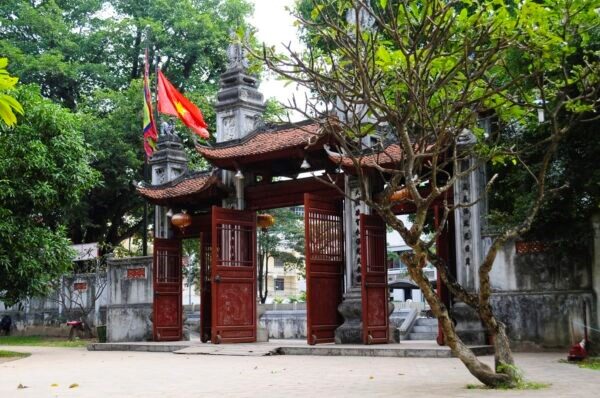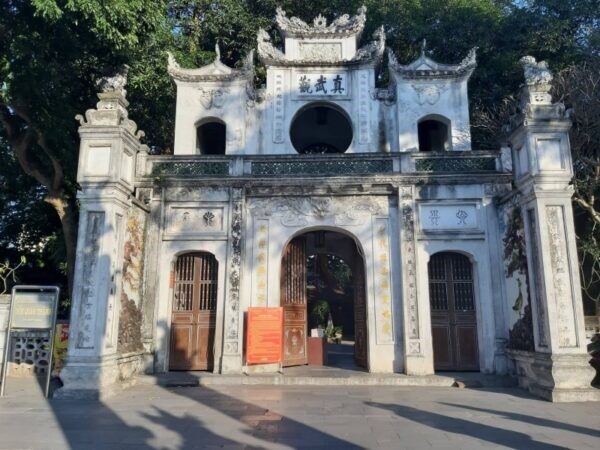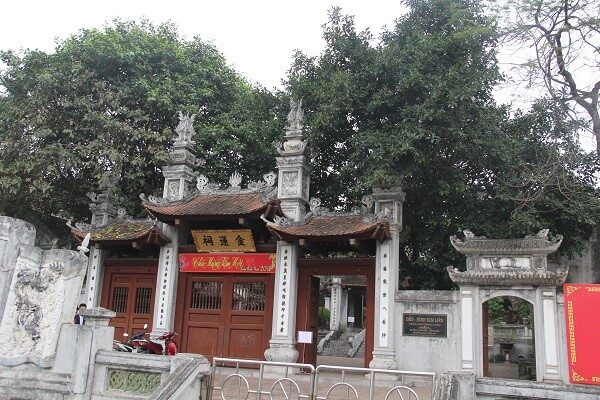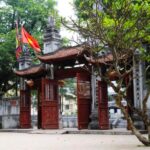Deputy Prime Minister Vu Duc Dam has just signed the decision to rank special national monuments (phase 12) for 5 relics. Among which are the Four Sacred of Hanoi, including Bach Ma temple (Hoan Kiem district), Voi Phuc temple, Quan Thanh temple (Ba Dinh district), and Kim Lien temple (Dong Da district). They are 4 sacred temples built to worship the 4 gods who guard the lifeline positions of the land of Thang Long. In the past, these temples were often visited by the king to offer incense at the beginning of the year…

Bach Ma Temple
Photo: Internet
Bach Ma Temple was built during the Tang Dynasty when Cao Bien built La citadel in 866. Then, when Ly Cong Uan moved the capital from Hoa Lu to build Thang Long citadel in 1010, it was rebuilt. The temple was built in the 三 shape with an 8-roof communal house outside. The unique feature of this architectural work is the crab shell-shaped roof system (crab shell) linking the architectural items. This creates a closed, continuous connection, increasing the space for the monument, creating a different and rare highlight of the monument compared to many other relics in the Northern Delta. The temple still retains many valuable artifacts of the late 17th century art style, perhaps added in the renovation in the 8th year of Chinh Hoa Era (1687). The temple now preserves 18 ancient stone steles recording the repair of the temple, 17 ordinations granted by the Nguyen court, and many other precious objects of worship.

Voi Phuc Temple
Photo: Internet
Voi Phuc Temple is located to the west of the old Thang Long citadel, now in Ngoc Khanh ward (Ba Dinh district). It is the place to worship Linh Lang – the god believed to help the king take care of the peace for the west of the Imperial Citadel. The gate is made in the form of four pillars, like the cosmic axes that bring vitality from the heaven to the earth. On both sides of the gate, there are steles and a couple of elephants in adoration. The road to the courtyard has three paths. In the middle, there are 12 wide stone steps only used for the procession of palanquins during the holidays. In normal situations, people often walk on the two side paths. In front of the middle aisle is a square well that means gathering water to gather happiness. In the past, water from this well was used to worship gods. Asking for water also means asking for satiety. It is reflected in the “rounded” stone rattan dragons, a product of the mid-nineteenth century, and the two embosses tigers attached to the two sides of the main door, bearing the standard. The main temple has the shape of the “I” word. The sacrifice has compartments, the beam crosses the pillar, and the roof is roofed with tiles of the ancient toes. The middle compartment is a pavilion running along the inside connecting with the harem. This building is placed with a large throne carved with dragons and meticulous flowers, carrying the breath of the 19th century art. Under the throne to worship the god is a statue of two generals kneeling in adoration. The harem also has 5 compartments, the middle one in the deepest position and the highest one is the statue of Linh Lang Dai Vuong with a delicate and noble face. In front of his statue is a large stone placed in a glass box. The stone has an indentation. It is said that the god used to rest his head on this stone. On either side of the stone are statues of two assistants standing in adoration. In the temple, in addition to the statues, there are also diaphragms, couplets, incense sticks, long thrones, bowls of hammocks and sacrifices, all of which are painted with splendid gold.

Quan Thanh Temple
Quan Thanh Temple is located on the corner of ancient Co Ngu Street (today’s Thanh Nien Street). It overlooks West Lake, worshiping Huyen Thien Tran Vu God. The temple was built in the style of “nail”, “country, outside is the four-pillar ritual, followed by the steeple where the bell was cast in the year of Dinh Ty, Le Hy Tong dynasty (1677), inside is the royal court and the harem. On the left and right sides of the great cult, there is a bronze sign “De Chan Vu Quan”, written by King Thieu Tri. A special thing about Quan Thanh temple is that in the harem, there is a statue of Huyen Thien Tran Vu cast in 1677. The statue is 3.96 m high and weighs 4 tons. The statue has a round head, wearing a draper hat, has big ears, a full face with wide eyes, a balanced nose, a closed mouth, a long beard… exuding the spirit of a Taoist. The statue is wearing a cloak in his body. Inside, there is an armor, with a tigerhead-shaped seal at the waist, dotted with leaf-shaped patterns and surrounded by round beads. His cloak is folded, the back flap falls below the hips, the sleeves are loose, falling quite low. The armor has two flaps on the chest decorated with lotus pattern and a five-clawed dragon hidden in the clouds. The statue has catfish beard, thin body, looks quite fierce. In addition to the famous bronze statue above, Quan Thanh Temple also has other very large bronze objects such as the bronze medallion from the Tay Son period, a pair of elaborately carved bronze lamps, the copper cauldron, bronze incense burner… and 52 sets of parallel sentences from the ages.

Kim Lien Temple
Photo: Internet
Kim Lien communal house and temple (also known as Cao Son temple) was built on a high mound in the east of Kim Lien lagoon. The gate and the main door are both facing the west, overlooking the Kim Lien lagoon (the lagoon has been filled to make the ring road 1). The main hall includes Nghi Mon, Dai Bai and Forbidden Palace. Nghi Mon is a three-room house, built in the style of a back wall. On the architectural parts, the decorative motifs are vividly and elaborately shown in the artistic style of the Nguyen Dynasty. Dai Bai consists of 5 new compartments embellished by the city on the occasion of the 990th anniversary of Thang Long-Hanoi, with traditional architectural designs. The harem is a house with three vertical compartments, the last one is the place to worship Cao Son Dai Vuong and two goddesses of harmony (Ton Nu Dong Ho Trung Vuong (princess, daughter of King Le) and Princess Hue Minh. The communal house was repaired and restored in 2009. About important relics at Kim Lien communal house, in addition to the stone stele “Cao Son Dai Vuong, god of compassion”, there are 39 ordinations for Cao Son Dai Vuong, of which 26 are under Le Trung Hung and 13 under the Nguyen Dynasty. The one with oldest history was ordained in the second year of Vinh To (1620).
According to the Decision, the relic protection area is determined according to the minutes and the map of the relic protection areas in the dossier. The Minister of Culture, Sports and Tourism, the Presidents of the People’s Committees at all levels where the above-listed relics are located, within the ambit of their duties and powers, perform the State management of the relics in accordance with the provisions of cultural heritage law.
Nguyen Minh

